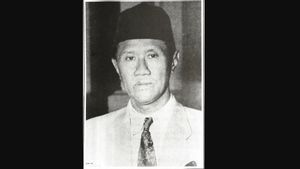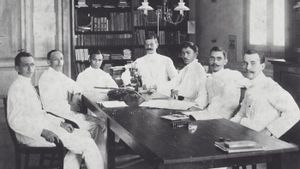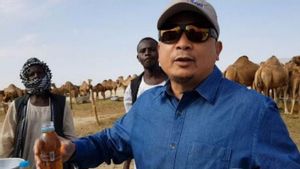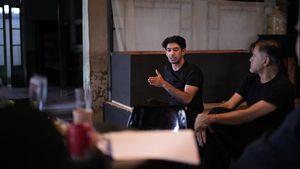JAKARTA - The love of Indonesia's first president, Soekarno, for art is unquestionable. A number of literature confirms.
Because of Soekarno's deep love for art, Cindy Adams, the author of his biography, Bung Karno: Penyambung Lidah Rakyat (1965), once wrote:
The easiest way to describe Bung Karno is by calling him an all-lover. He loved his country, he loved his people, he loved women, he loved art, and more than anything else he loved himself.
After Bung Karno and Hatta announced the proclamation of independence that was able to burn all the spirit of the Indonesian people on August 17, 1945, Bung Karno did not let his guard down. Later, he invited all the people to always be aware of the fact that the Dutch were trying to reclaim the Dutch East Indies.
Strength was gathered. Weapons are ready. Capital sought. And the artists were then involved to ignite the people's enthusiasm through their work. In this phase, Bung Karno proved that the revolution did not only come with rifles, funding, and sharp objects.
More than that, the revolution needs a touch of art to burn the spirit of the nation, the spirit to protect independence. "But I thank the Almighty Creator because I was born with a delicate feeling and artistic blood. Otherwise, how could I become the Great Leader of the Revolution, as 105 million people call me?" as written.
“Otherwise, how can I lead my nation to reclaim its independence and rights, after three and a half centuries of Dutch colonial rule? Otherwise, how can I wage a revolution in 1945 and create a unified Indonesian State, consisting of the islands of Java, Bali, Sumatra, Kalimantan, Sulawesi, Maluku Islands, and other parts of the Dutch East Indies? " he continued.
The birth of the poster "Bung, Ayo Bung"
Not surprisingly, Bung Karno immediately ordered the famous painter of his day, Affandi, to make a poster to ignite the spirit of the Indonesian people. As quoted from Seno Joko Suyono and Andi Dewanto in Tempo Magazine entitled Pipa Cangklong, Rubiyem, dan Kolonel Sanders (2007), he shared the details.
In 1945, Affandi got the task of making posters of the struggle. Bung Karno emphasized that the order must contain pictures of people in chains and chains that had been broken. It so happened that Dullah was a model at that time. As a result, after finishing his drawing, Affandi seemed to need pithy words that could raise the spirit of struggle.
poster "Boeng, Ayo Boeng" - Afandi @kawanIVAA pic.twitter.com/8jBsq5dy6w
— Konferensi Demokrasi (@KonDem2016) December 7, 2016
Luckily, the famous poet Chairil Anwar passed. Without further ado, painter Soedjojono - grandfather of Arian Arifin Wardiman, vocalist of the band Seringai - asked what words were suitable for Affandi's paintings. "Lightly, Chairil answered, 'Bung, Ayo, Bung!'" (Sir, Come On, Sir! -ed).
So, the poster created by Affandi with the words donated by the poet who was nicknamed Sang Binatang Jalang (The Bitchy Animal -ed) was perfect. After that, the posters were then reproduced to be sent to various regions by a group of painters day and night.
Instantly, the rhythm of "Bung, Ayo, Bung!" blared as a heroic expression, which seemed to be able to evoke a narrative of protecting the whole nation and all the Indonesian blood.
Uniquely, his fellow artists tried to ask Chairil where the inspiration for this expression came from. Immediately, Chairil shamelessly shared that the phrase "Bung, Ayo, Bung" came from the invitation call of the Senen prostitute when they offered their services.
Every time a customer comes in, a flirtatious-gentle tone leaks straight out of the prostitute's mouth: Bung. Ayo, Bung. Suddenly, the fellow artists who heard it couldn't help but laugh. They did not expect the thing that inspired Chairil to make magical expressions came from prostitutes.
SEE ALSO:
However, whatever it is, the phrase originating from invitation to take a playboy into bed actually has a role in a long revolution. And that's the greatness of a person who is considered a pioneer of generation 45.
Allegedly, this phrase is often heard by Chairil, who spends time at Pasar Senen every day. At that time, Pasar Senen was known as the epicenter of Jakarta artists. "During the Japanese occupation 1942-1945, Pasar Senen was also a stopover for artists, because the poet Chairil Anwar often appeared there," wrote Misbach Yusa Biran in the book Keajaiban di Pasar Senen (1971).
Even so, the word 'bung' on the poster, if traced, was familiarly used during the revolutionary period. The proof, researchers like Benedict Anderson who came to Indonesia in 1961 revealed the same thing. Through his book, Hidup di Luar Tempurung (2016), Ben reveals that the word 'bung' is a word that is often used widely and implies equality and brotherhood.
Typically, this word is used as a nickname between fellow men. As proof, Son of the Dawn, Soekarno, is widely known as 'bung' which indicates that between himself and the Indonesian people there is no dividing line. Moreover, the word 'bung' is often synonymous with "citizen" in the French Revolution, or "comrade" in the Russian Revolution.
The English, Chinese, Japanese, Arabic, and French versions are automatically generated by the AI. So there may still be inaccuracies in translating, please always see Indonesian as our main language. (system supported by DigitalSiber.id)













